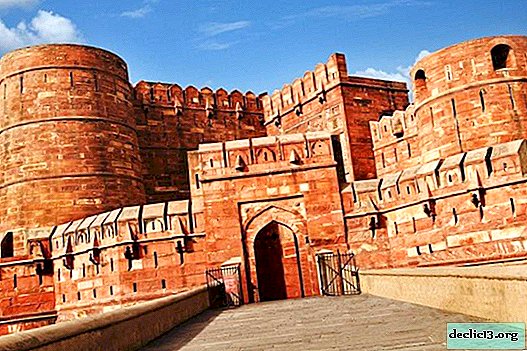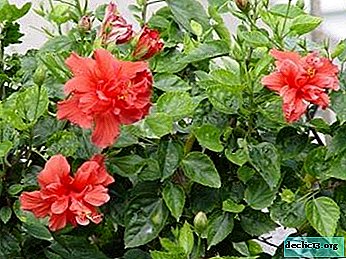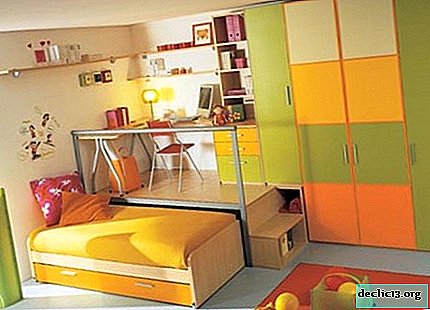Red Fort in Agra - memory of the Mughal Empire
Agra Fort in India is one of the most beautiful defensive structures in the country, the name of which is closely related to the color of the sandstone used for its construction. It is the "twin" of the Red Citadel in Delhi.

General information
The red fort of Agra is an impressive fortification, which in the era of the Mughal Empire served as the main residence of their rulers. Like the Taj Mahal, a short drive away, it is a UNESCO World Heritage Site and is protected by the state.
Entering the list of the most beautiful bastions of India, Agra Fort is more reminiscent of a separate city, stretching along the left bank of the Yamuna for as much as 3 km. Here, behind the double fortified walls, whose height reaches 20 m, a whole complex of parks, palaces, temples, pavilions, mosques and squares is hidden. Currently, the Red Bastion of Agra is not only the most important Indian attraction, but also an active military facility actively used by the local army. Due to this, a certain part of the complex is closed to visitors.

Short story
The construction of the Red Fort in India began in the second half of the 16th century, when the paddish Akbar the Great decided to transfer the capital of his empire from developed Delhi to the provincial and unknown Agra. According to the records left by the court historian, the base for this bastion was the old dilapidated Badalgar fortress, which local builders were able to not only completely restore, but also turn into one of the most powerful fortifications in India.
By 1571, the building was surrounded by a powerful protective wall lined with red Rajasthan sandstone and equipped with four tower gates. After some time, two of them were walled up.
Over the following years, the territory of the Red Fort expanded significantly. Moreover, the numerous successors of Akbar the Great were happy to remake it to your taste. If at the first stages of construction preference was given to red brick, which was only occasionally diluted with snow-white marble elements, then under Shah Jahan marble with patterns of gold and precious stones became one of the main building materials. The result is a beautiful palette that includes a red and white tint.

In 1648, the capital of the Mughal Empire was moved back to Delhi, and the fortress itself, which at that time completely lost its significance, served as the last refuge for one of its creators. In subsequent years, the Red Fort Agra in India was in the possession of various dynasties, and in the mid-19th century was the center of armed clashes between Indian and British troops. But, despite all the hardships that fell on his lot, he managed to perfectly survive and become one of the most famous Indian attractions.
Fortress architecture
The red fort in Agra, built in the shape of a crescent, combines several architectural styles, the most striking of which are Islamic and Hindu. Two massive gates form the entrance to the complex. If the former, the Delhi, are used only by the military, the latter, the Lahore or, as they are also called the Gate of Amar Singh, are intended for the entrance of numerous tourists. Their broken design was to confuse the attackers who managed to overcome the obstacle in the form of a moat teeming with crocodiles. Now this is the first place in which you can make a lot of interesting photos.
 Lahore Gate
Lahore GatePreviously, 6 palaces and mosques were located outside the walls of the Red Fortress, but over time, some of them were almost completely destroyed. Of those that have been preserved, it is worth highlighting the Jahangiri Mahal, a luxurious multi-storey palace built by Akbar the Great for his wife. The white stone structure, consisting of several rooms, impresses with its fine marble carvings and exquisite decoration. The walls of the palace are decorated with paintings painted in oriental style, and blue-gold painting, applied directly to the plaster. In the courtyard you can see a huge pool of stone, designed to store rose water and complemented by Persian poems carved in decorative print.
The Khas Mahal, the personal apartments of Shah Jahan, built in 1636, deserves no less attention. On both sides of this building there are golden pavilions in which the emperors' wives and concubines used to live, and in front of the palace there is a vineyard, the marble paths of which were used for romantic walks.
 Khas mahal
Khas mahalIn the north-eastern part of this garden is Shish Mahal or the Mirror Hall. At one time, he played the role of the imperial bath, in which numerous court ladies loved to splash around. Thick walls and ceilings that provide coolness are inlaid with countless mirrors. Interestingly, in the baths there is not a single window, and the light enters the halls only through the doors and the ventilation hole, arranged in the southern wall. All this creates a dramatic effect, reminiscent of an episode from some science fiction film. In the center of this building is a giant marble cistern with fountains, however, only a select few can see it and unique mirror patterns. Unfortunately, a few years ago, Shish Mahal was closed to most tourists. Today it is opened only for VIP guests, heads of state and international delegations, but for a small fee you can still get inside at least for a short time.
Another component of the Red Fort in India is Divan-i-Khas, a separate room designed for private imperial audiences. Once upon a time, its walls were decorated with beautiful patterns of precious stones, but after the fortress passed into the possession of the British Empire, all the jewelry was taken to one of London's museums. They say that it was here that Shah Jahan lived out the last days, contemplating the Taj Mahal and recalling past greatness. Previously, the legendary Peacock Throne, encrusted with diamonds, rubies and sapphires, stood in this hall, but in 1739 it was transported to Delhi, and then completely disassembled into separate parts.
 Sofa and khas
Sofa and khasAt some distance from Divan-i-Khas stands the Tahti-i-Jehangar Palace, built by Akbar for his son. Its architecture combines elements of several styles at once - Indian, Asian and Afghan. Before entering the building, you can see a huge bowl carved from a solid block of stone and used as another bathhouse.
Going a little further, you will see Divan-i-Am, a hall for conducting government affairs, to the left of which there is a spacious courtyard. Now on its territory there is only a small Precious Mosque, built by the emperor for court ladies, and once there was also the Women's Bazaar, where local women could buy all the goods they needed.
Among other things, the Red Fort has a whole system of underground tunnels, the most famous of which is the two-story labyrinth, which served as the main residence for 500 Akbar concubines.
Practical information

- Agra Red Fortress is located at: Rakabgani, Agra 282003, India.
- It is open daily from 06:30 to 19:00.
- The entrance ticket costs 550 rupees (a little less than $ 8), for Indians - 40 rupees. Admission is free for children under 15 years old. Tickets are sold at the south entrance gate.
Look for more information on the official website - www.agrafort.gov.in
Useful Tips
Currently, Agra, a fort in India, is one of the most visited sites in the country. If you also plan to get to know this famous Indian landmark, take a look at a few helpful tips:
- Before entering the Red Fortress, each visitor is checked with a metal detector, so weapons, flammable objects, electrical appliances (except the camera), chargers and other prohibited items are best left at the hotel.
- It is also impossible to drink alcoholic beverages and smoke tobacco products in the territory of the fort - for this it is strictly punished.
- No less strict prohibition applies to food, so do not even try to bring snacks, sweets or fruits with you. The only exception is water, but one can take no more than 2 small bottles.
- When walking around the Red Fort, do not forget to turn off the sound on your mobile phone.
- Try not to touch the walls and scratch them with anything - remember that they are World Heritage sites and need special care.
- Staying on the territory of the monument, behave more modestly, do not run, do not make noise.
- To explore the local sights, you should arm yourself with a detailed audio guide or hire a professional guide. Otherwise, miss a lot of interesting stories.
- To get a good discount, buy a complex ticket that includes a visit to the Red Fort and the Taj Mahal.
- There are many small cafes on the territory of the fortress, of which it is nice to watch the sun go down.
- You can stay in the Red Fort until closing time. If you have free time, stay until the evening - at this time there are great light shows.

Tour of the Red Agra Fort with a local guide:

















